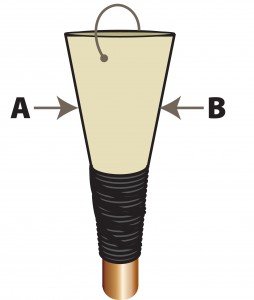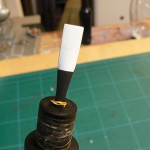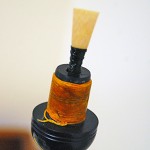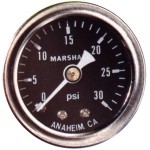4 Steps to Revive Dead Chanter Reeds
 Never chuck a good reed. A good chanter reed that has served you well may still do so even after it has dried out or turned “wimpy.” As long as it has no damage and is not in a state of decomposition, the reed can be revived and brought back to its former glory for a time. There many tales that tell how to bring old chanter reeds back into action. All have their merits and are worth experimenting with if you’re a brave and enterprising pipehacker. Here is a one method for that moment when an emergency backup reed is desperately needed, like say, when you accidentally nick the corner off of your current (but last) good reed and that contest is just a couple of days away. Far from ending up with a “zombie reed†that sounds like the walking dead, the resuscitated chanter reed will continue to serve for a time. Follow these quick steps to bring used reeds back into service.
Never chuck a good reed. A good chanter reed that has served you well may still do so even after it has dried out or turned “wimpy.” As long as it has no damage and is not in a state of decomposition, the reed can be revived and brought back to its former glory for a time. There many tales that tell how to bring old chanter reeds back into action. All have their merits and are worth experimenting with if you’re a brave and enterprising pipehacker. Here is a one method for that moment when an emergency backup reed is desperately needed, like say, when you accidentally nick the corner off of your current (but last) good reed and that contest is just a couple of days away. Far from ending up with a “zombie reed†that sounds like the walking dead, the resuscitated chanter reed will continue to serve for a time. Follow these quick steps to bring used reeds back into service.
1. Wet the reed thoroughly. Place the reed in a small amount of water for a minute or two or wipe the blades across a wet sponge. You want to swell the can fibers and seal up any openings between the blades.
 2. Open the body, let the reed air dry. Take the reed out of its bath and lay it out on a cloth or towel. After the reed is dry, gently squeeze the reed at the sides (at points A and B on the image) while holding the tips of blades together. You want to open up the body and soundbox. Check for leaks at the sides and if you have leaks, repeat the first step.
2. Open the body, let the reed air dry. Take the reed out of its bath and lay it out on a cloth or towel. After the reed is dry, gently squeeze the reed at the sides (at points A and B on the image) while holding the tips of blades together. You want to open up the body and soundbox. Check for leaks at the sides and if you have leaks, repeat the first step.
3. Clean the inside of minute dirt particles or fibers. You will come across several ways to do this, some as old as the hills. One way is to blow a small amount of whiskey through the reed from the staple end. Another way is to run a feather soaked in whiskey or some other spirit through the reed. The common thread is the alcohol. In old days, whiskey was the spirit of choice. Vodka or grain alcohol is preferable since they contain fewer sugars. A strip of cigarette rolling paper dampened with vodka/alcohol and pulled through the reed will achieve the same goal. Be gentle.
4. Adjustments. The reed may be back to playing condition, but it could be weary. The blades may be weak and its pitch may not be up to snuff. To get the reed back to its former crispness and resonance, it might be necessary to cut a small bit away at the very top of the blades. Use a very sharp blade and make the smallest cut you can.
 Pipehacker
Pipehacker








